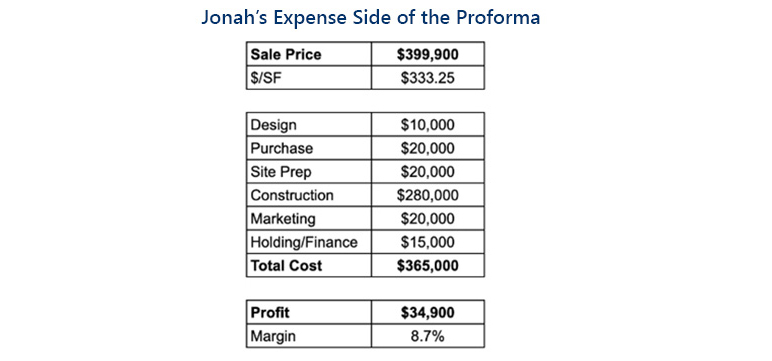- Navigator
- Rural
- Construction and Utilities
- Real Estate Development and Housing
 “Missing middle” is a term used to describe the lack of housing options available on the market (particularly homeownership) for middle-income earners. It was coined on the heels of the Great Recession (2007-2009) when housing production ground to a halt following the financial meltdown.
“Missing middle” is a term used to describe the lack of housing options available on the market (particularly homeownership) for middle-income earners. It was coined on the heels of the Great Recession (2007-2009) when housing production ground to a halt following the financial meltdown.
In cities and suburbs, planners and developers can sometimes use housing-unit volume to reach missing middle price points, but what about rural communities where volume isn’t viable?
In this article, I will share one homebuilder’s experience developing a missing middle home and provide insights on what rural towns can do to participate, incentivize, and promote missing middle construction.
Jonah Richard is a homebuilder and developer in Vermont. He hosts a popular blog on Substack called Brick + Mortar, where he shares his experiences and observations of the housing sector.
Recently, Jonah highlighted a demolish-and-rebuild project near a village in Vermont with the goal of making the end product affordable to a double-income household earning $25/hour (equal to $104,000 annually). To keep the mortgage payments below 30% of that household’s income, the sale price would be capped below $400,000.
To layer on the challenge, Jonah endeavored to build an energy-efficient house using quality materials. The final product would be under 1,300 square feet (SF) with three bedrooms and two bathrooms — a bonafide starter home.
Missing Middle Homebuilding: Setting the Stage
This challenge came together on an opportunity site. Jonah noticed an abandoned house falling into the ground not far from the village center. He was able to acquire the house and its half-acre of land for $20,000. It cost him another $20,000 to clear the site for construction. The parcel was already on public sewer and water and had electric service. Located right on the main road, all it needed was a short driveway.
Right away, these factors represented substantial savings that are typically barriers to building missing middle housing. Land costs are often cost-prohibitive, and installing utilities comes at a steep price. New road construction is not cheap either. Site prep costs for a parcel not already connected to utilities could be $60,000-$90,000 just to make it construction-ready, and that’s on top of the cost of purchasing the land. Prices per acre for undeveloped land in rural markets can be tens of thousands of dollars.
Prepping the site for new construction (left). At right is the chosen design for an energy-efficient home. Photos courtesy of Jonah Richard, Brick + Mortar
Running the Numbers
Jonah is in an advantageous position because he is both the developer and the construction company owner. This cancels out one profit margin, whereas both the developer and the construction company owner need to get paid in other, more common circumstances.
Another factor is Jonah’s financial stability. He is comfortable accepting a lower profit margin in this instance. He is anticipating an 8.7% return on his investment (the difference between his costs and the sales price). Many private housing developments need to provide a 12% return on investment to be considered worth the risk and attractive enough to be prioritized by developers.
To save costs, Jonah hired the same architect who designed a project he wanted to emulate and asked the architect to just recycle those plans. This significantly lowered his design costs.
If all the pieces fall into place and there are no setbacks, Jonah will see a profit of about $35,000 from this project. But Jonah assumes all the risk, and if the numbers don’t align, his construction workers still need to get paid.
Movable Factors
Some factors required Jonah to make assumptions based on current interest rates, and if they change soon, they could impact the affordability of the final project.
The first factor is the anticipated mortgage interest rate. Jonah plugged in 6.5%, which was the prevailing rate in August 2024 — it also assumes the buyers can get financed at that rate with high enough credit scores.
The Federal Reserve is anticipated to lower the central bank’s lending rate in September, which should reduce mortgage rates this fall. If rates fall to 6%, that half-a-point difference will reduce the salary ceiling of prospective buyers by $4,000 (or about 4%) — not a lot, but it’s something if buyers are making a financial stretch to buy a home.
The second rate that’s been built into the formula is market-rate construction loan interest. At the time of this writing, construction loan rates were around 7.5%. Rates could come down, but it also assumes no access to grants or subsidies.
Grants vary by state — even the allocation of federal programs like low-income housing tax credits (LIHTC) is overseen by state agencies — and often, administrative hurdles, lack of awareness, qualifications, and funding limits are all barriers to accessing the programs.
In addition to site prep, design, construction, and financing, Jonah has budgeted $20,000 to market the sale of the property.
What Role Can a Local Government Play in Developing More Missing Middle Housing?
In the list of expenses for the construction of a missing middle home, local governments might be able to influence the affordability of the project and its viability for the developer.
- They can make Town-owned land available for free (or at a discount) to a builder of missing middle housing. (Sometimes an altruistic community member might discount land, too.)
- They could budget to prepare the sites to be construction-ready, ideally with public works equipment and crews.
- If the local government is providing some assistance to a project, they might partner with a local bank that could pre-qualify buyers and create a waiting list for the purchase, removing marketing expenses. Both the city/town/village and the bank would publicize the new price-capped houses for sale.
- They could establish a revolving loan fund for home construction (likely financed with a bond), decreasing builder borrowing costs.
With Jonah’s project, these four aspects amount to $75,000 in the developer’s expense budget. If those four expenses were removed entirely from the sale price of the house, the new price would be $324,900.
Conversely, if the public investment went entirely to subsidize the developer, the return on the project would be up to 28%!
The right balance would be to provide some subsidy to the developer to get a return closer to 12%, retaining some funds for the local administration (by applying a low lending rate instead of 0% or a modest sales price for the publicly owned land), and using some subsidy to reduce the sale price for more eligible buyers.
In all cases involving local subsidy, the municipality should instate a legal covenant on the property that caps any future sales price at a rate affordable to middle-income earners. The owner can still build equity and profit on a future sale, but the price point would have a ceiling.
Takeaways
Private builders and lenders will only participate in building more missing-middle housing if the development is closer to a 12% profit margin. Until those numbers line up, homebuilders will continue focusing on high-end houses with higher profit margins or renovation projects where the customer pays cash (no sales risks).
Local governments do have some levers they can pull to make building missing middle housing more attractive to the private sector, specifically by offering publicly owned land, prepping it for construction, lending on the construction, and lining up buyers. This level of public participation will absolutely attract the attention of homebuilders eager to deliver new missing middle housing.
Camoin Associates assists communities large and small across the county in understanding their local housing market, assessing needs, and discovering new opportunities to spur development. Contact Senior Housing Specialist Robert O’Brien at robrien@camoinassociates.com to explore ways Camoin Associates can get your local housing market working for you again.
📍 Related Articles:
- No Vacancies: Affordable Housing Growing Scarce in Rural Communities
- Moving the Needle: 5 Ways Local Governments Can Help Address the Housing Shortage
- Demystifying Deed-Restricted Affordable Homeownership: Is it Right for Your Community?
- Manufactured, Panelized, and Modular Homes: New Models for Housing Affordability?
- From Vision to Value: Assessing Financial Feasibility in Real Estate Development




